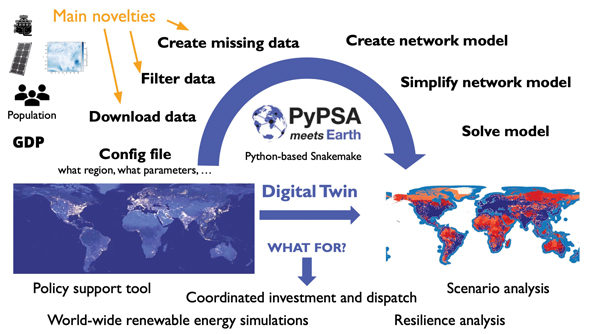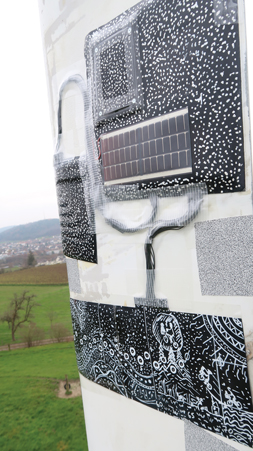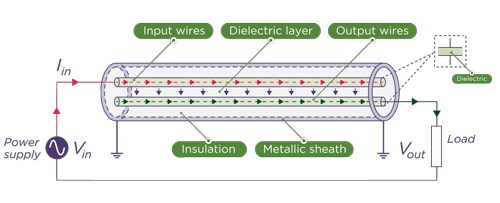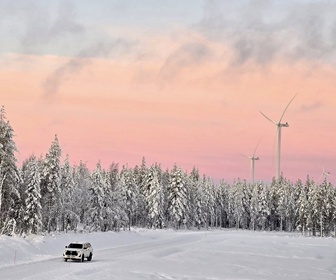- Category: Articles
 Combining SAR Measurements, Models, Lidar and Artificial Intelligence
Combining SAR Measurements, Models, Lidar and Artificial IntelligenceOffshore wind resource assessment (WRA) is a challenge due to the scarcity of measurements at hub height. The 18-year database of European synthetic aperture radars (SAR) provides worldwide sea surface wind measurements at 1-kilometre resolution. Through an innovative vertical extrapolation methodology these long-term, wide, high-resolution observations can complement in situ observations and mesoscale modelling for offshore WRA. The methodology is based on four steps: derivation of the 10-minute SAR surface winds from SAR sea surface roughness, a site- and time-independent machine learning algorithm based on a large buoy network to correct SAR surface winds, extrapolation up to 250 metres based on a second machine learning algorithm trained with in situ observations and physical parameters from a high-resolution mesoscale model related to atmospheric stability, and a final post-processing step to correct for low temporal sampling of the SAR database and to retrieve wind statistics.
By Mauricio Fragoso, Director, Energies and Infrastructure Monitoring, CLS, France
- Category: Articles
An Open Tool and Community to Support Earth Decarbonisation
To meet decarbonisation targets, large investments are needed and digital tools are essential to minimise costs for citizens. The open paradigm composed of open data and open-source tools has the potential to break down costs and improve transparent decision-making. In this article, we describe how the open research initiative PyPSA meets Earth is creating a worldwide community that welcomes anybody contributing towards open tools, like PyPSA-Earth, to support the energy transition.

In particular, we describe how the PyPSA-Earth modelling tool is able to identify the least-cost energy mix for the energy system of any country in the world, while meeting environmental targets. A case study of Saudi Arabia shows that PyPSA-Earth could help the country achieve its Vision 2030 goals, reducing emissions by 50% and transitioning away from fossil-fuel-based generation methods. This proves that open energy modelling is state-of-the-art with strong applications in industry and policy decision-making.
By Dhruv Suri, Davide Fioriti, Maximilian Parzen, Stuart Daniel James, Ekaterina Fedotova
- Category: Articles
 How Smart Curtailment Systems Can Improve Wind Farm Revenues
How Smart Curtailment Systems Can Improve Wind Farm RevenuesBat fatalities resulting from collisions with wind turbines have been extensively documented at operating wind farms throughout the world, but they are of particular concern in the USA, where the ranges of several endangered bat species overlap with a large number of operating wind farms. One leading mitigation measure involves curtailing the turbines during relatively low wind speed periods when bats are likely to be present. This has been shown to reduce bat fatalities significantly. While curtailment helps reduce bat mortality, it comes at the cost of lost revenue because the turbines are not producing power even though the wind is blowing. A better way to approach mitigation is to use a smart curtailment system that detects bat activity and modifies the operation of the turbines accordingly. This article explains how this system works and its operational and mitigation benefits.
By Dr Chris Ziesler, Roger Rodriguez, Taurin Spalding, Devin Saywers, Natural Power Consultants, USA
- Category: Articles
 Capturing More Wind with Breakthroughs in Optimisation
Capturing More Wind with Breakthroughs in OptimisationIn the wind industry, our collective mission is crystal clear. It is to maximise the energy that we capture at the lowest cost and lowest environmental impact. The amount of progress that has been made over the last two decades towards that goal is nothing short of extraordinary.
By Marouane Salhi, CEO, Qubit Engineering, USA
- Category: Articles
 Blade Surface Aerodynamic Pressure Measurements
Blade Surface Aerodynamic Pressure MeasurementsBoth the aerodynamic/acoustic design of the rotor blades and their performance during operation can be improved by measuring the aerodynamic surface pressure distribution. For blade design, an understanding of the three-dimensional (3D) unsteady aerodynamics can allow the aerodynamic profiles to be optimally chosen and distributed along the blade length. An understanding of the acoustic emissions can allow the blades to be optimally designed in terms of noise production and to identify and avoid undesirable effects such as flow separation. For wind farm operation, an understanding of the 3D unsteady aerodynamics can allow controller settings to be optimised depending on the site and layout conditions, as well as leading edge erosion and even structural damage to be detected and classified. This can support decisions for maximising production and optimising the maintenance strategy. The Aerosense MEMS-based surface pressure and acoustic smart measurement system seamlessly enables the acquisition and exploitation of such measurements in an industrial setting for the first time (Figure 1).
By Sarah Barber, Head of the Wind Energy Innovation Division, Eastern Switzerland University of Applied Sciences, Switzerland
- Category: Articles
 Capacitive Transfer System Cable for Efficient Wind Energy Integration
Capacitive Transfer System Cable for Efficient Wind Energy IntegrationEnertechnos has developed an innovative cable design called the Capacitive Transfer System (CTS), which delivers a substantial change in power system design while providing significant benefits to wind developers and owners, including power loss reduction, improved reactive power management, and the potential for reduced operating voltage or reduced size and weight of cables through increased current density. Case studies demonstrate that CTS cable can deliver more power over the same cross-section, thus allowing reductions in copper use and the associated carbon footprint.
By Dr Alexander Yanushkevich, Owen Johnson and Sebastian Amedick, Enertechnos, UK
- Category: Articles
 Grid-Enhancing Technologies Unlock Dynamic Transmission Capacity for Renewables
Grid-Enhancing Technologies Unlock Dynamic Transmission Capacity for RenewablesEven areas with persistent transmission congestion and associated renewable energy curtailment have gigawatts of untapped transfer capacity. With grid-enhancing technologies – hardware and software tools that turn the grid into a flexible and dispatchable asset – grid operators can unlock more value from existing infrastructure.
By Julia Selker, Executive Director, WATT Coalition, USA
Use of cookies
Windtech International wants to make your visit to our website as pleasant as possible. That is why we place cookies on your computer that remember your preferences. With anonymous information about your site use you also help us to improve the website. Of course we will ask for your permission first. Click Accept to use all functions of the Windtech International website.










